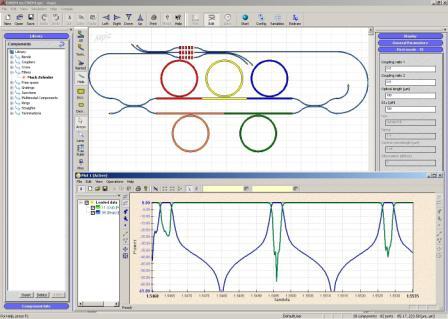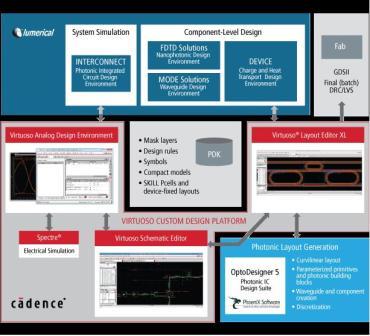The 50 year anniversary of the publication of Moore’s Law was recently celebrated, highlighting the tremendous advances in the Microelectronics Eraof the period in human history known as the Information Age. However, the technical and economic challenges currently faced by the microelectronics industry are bringing into question the pace at which product innovations realized under Moore’s Law can continue. Nevertheless, the sheer data volume and demand for information processing throughput is accelerating.
I recently had the opportunity to meet with Gilles Lamant, Distinguished Engineer at Cadence, and several members of the development teams at Lumerical Solutions, Inc., and PhoeniX Software B.V., who presented a compelling case that the future of the Information Age will be defined in a new manner, namely The Era of the Photon.
The demand for faster signal communication in short-reach applications – e.g., both within and between compute servers in data centers – will rapidly transition from lossy copper to optical fiber connectivity, utilizing photonic integrated circuits (PIC’s).
Photonics is a broad term, which encompasses the use of light (photons) to represent information, spanning photon generation through transmission to detection. Optical signaling technology has been the backbone of the telecommunications industry for decades. Optical image sensors are the heart of numerous consumer and industrial product sectors. The utilization of optical communication for data system applications is relatively new, and is expected to grow rapidly.
Photonic devices for data representation and transmission incorporate familiar functionality as their microelectronic counterparts – e.g., multiplexers, modulators, amplifiers – with the additional requirement for electro-optical conversion and coupling to optical fiber. These PIC functions rely upon the precise dimensionality of waveguides fabricated on the IC, as illustrated in the layout below (from PhoeniX Software).

The design and simulation of the waveguide are extremely intricate steps, as the structure requires an (all-angle) curvature – more on that shortly. An attractive characteristic is that additional modulation can be achieved by changes in the refractive index of the waveguide induced by adjacent electrical or thermal stimulus, adding significantly to the simulation complexity. As a result of these intricacies, the current PIC industry is still very specialized, leveraging the expertise of companies such as Lumerical and PhoeniX to provide tools for design capture, model generation, simulation, and release to fabrication.
The fabrication of (discrete) PIC’s is also current rather specialized, typically leveraging unique III-V materials suitable for laser generation, waveguide implementations, and photon detection.
The growing demand for photonics is also driving unique implementations, such as the integration of separate (Si and III-V) signal processing and electro-optical conversion parts in a multi-die packaging solution. And, there’s extensive research underway to investigate fully-integrated, monolithic silicon photonics fabrication, extending existing CMOS process technology to include generation and detection feature. (The difference in refractive index between Si and SiO2 makes embedded silicon waveguides very feasible.) Indeed, several leading research teams have recently published promising results, in terms of potential aggregate bandwidth and low power dissipation per transmitted bit.
Cadence, Lumerical, and PhoeniX Software recognized that a key enabler to the growth of systems incorporating PIC designs is the availability of a productive and familiar design environment, whether for multi-die or monolithic devices. The three companies recently announced a photonic IC platform design flow, with interfaces between the following market-leading tools:
- Cadence Virtuoso
- PhoeniX Software’s OptoDesigner
- Lumerical’s INTERCONNECT and DEVICE modeling and simulation engines
The figure below highlights the tool integration and inter-operability available in this platform.

Designers will now be able to develop electrical and optical “circuits” in a Virtuoso-based environment, with links to the specialized tools from Lumerical and PhoeniX. This architecture builds upon the platform concept behind Cadence’s Virtuoso Analog Design Environment, with additional design and simulation support for photonic elements. (The availability of this environment will also promote the standardization of a photonics PDK release from foundries.)
As mentioned earlier, there are intricacies to photonic elements that are distinct from the traditional chip design and analysis methodology:
[LIST=1]
Photonic IC’s will become a much more prevalent part of system design. The investment in R&D of new materials and processes (especially, silicon photonics) is growing. This has necessitated focus on a more productive design environment, with specialized tool interfaces. Cadence, Lumerical, and PhoeniX have released an initial design flow, and are committed to expanding the capabilities (e.g., PDK standards, DFM/DFY, reliability analysis, etc.).
We are truly at the cusp of the Era of the Photon. It will be exciting to see how this next phase of the Information Age evolves.
More information on the recent platform design flow for PIC’s is available here.
-chipguy
Share this post via:






Comments
0 Replies to “The “Era of the Photon” is here!”
You must register or log in to view/post comments.